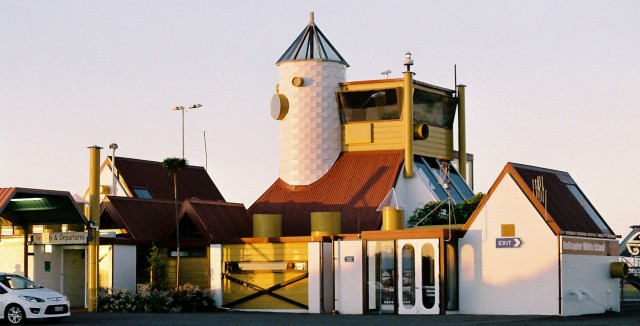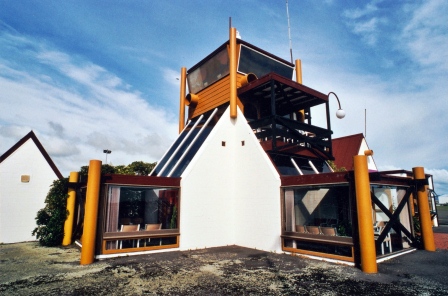Whakatāne Airport Recognised
Just over 12 years ago, I met my then new girlfriend’s father for the first time at a restaurant in Wellington.
“Where did you fly from,” I asked.
“Whakatāne,” he replied.
“Oh, I designed Whakatāne Airport.”
There was a pause (a nervous pause on my side).
“I like Whakatāne Airport,” he said.
And we’ve been good mates ever since.
And it is fair to say that not everybody loves it – it has its share of friends and foes.
But last week I was honoured to hear that Heritage New Zealand Pouhere Taonga has just added the Whakatāne Airport Terminal to the New Zealand Heritage List Rarangi Korero as a Category 1 Historic Place.
The citation states: ’The listing formally recognises the outstanding heritage values of the landmark building, which has become an iconic example of 1970’s award-winning architecture’
But a long side a feeling of pride, is also a sense of relief.
One of my early designs under my first employer Calder, Fowler & Styles, was The Wellington Club at 88 The Terrace, Wellington. This was sadly demolished too early into its life. A 3 storey building on an 18 storey site, was no longer seen as commercially viable.
There were moves at the Wellington City Council to protect it and a court case undertaken in order to save the building, but these were ultimately unsuccessful.
Whakatane Airport terminal has been under threat in the past.
The 1970s is regarded as a ‘coming of age’ of creative and espressive building unfettered by current regulatory requirements, and wanting to distance itself from familiar ordinariness.
Like many former colonies, New Zealand began to find its own architectural voice and I proud to have been part of this ‘breakout period’
So I am very pleased that this little building at Whakatāne has been recognised and has received a significant level of protection.
Critics of the listing have said that the preservation will prevent any future modifications, but this is an unimaginative stance, given that adaptive re-use of ‘assertive’ designs happens world wide .
The international Icomos Charter, governs management of Heritage buildings and Places by permitting sympathetic additions and alterations of a scale and design that respects the original.
A personal example I have of this is a small building I designed at my time at Calder Fowler & Styles, at the Taranaki Wharf edge. It was designed as a customs surveillance post at the side of the Union Company’s roll-on roll-off ramp and container terminal. Following the expiry of the Union Companies lease, the site subsequently became the home of our national museum, Te Papa .
At that buildings completion, there was pressure to demolish our strange little ’redundant’ building, because of the loss of its function.
However and happily, along came the Wellington Free Ambulance Service who wanted a presence in central Wellington and who saw the ‘chameleon eyes’ projecting windows not as a restriction, but a positive and appropriate expression of their function of looking out toward the community.
Too often buildings are designed to be neutrally ‘anonymous’ so that their occupants functions can change comfortably within a non expressive building.
I really dislike buildings that don’t express their function, because the built environment becomes the poorer for it. Just putting a cross on a warehouse doesn’t make it a religious building.
To me the richness of the built environment is that it provides a ‘library’ of buildings, each with their own story to tell. Buildings of suffocating ‘sameness’ denigrate our senses . This is why planned cities like Canberra or Brasilia are so boring and unloved.
My personal design journey began with an instinctive reaction to aspects of conventional design caused by my restrictive childhood environment. Whakatāne airport’s design comes out of my 1970s’ optimism and ‘creative naivety’. Over my subsequent 40 years of experience, I now balance innocence and knowledge. It’s a challenge I tell you.
I’ll have a celebratory drink to my Whakatāne Airport Building for its success in making a lasting statement.

